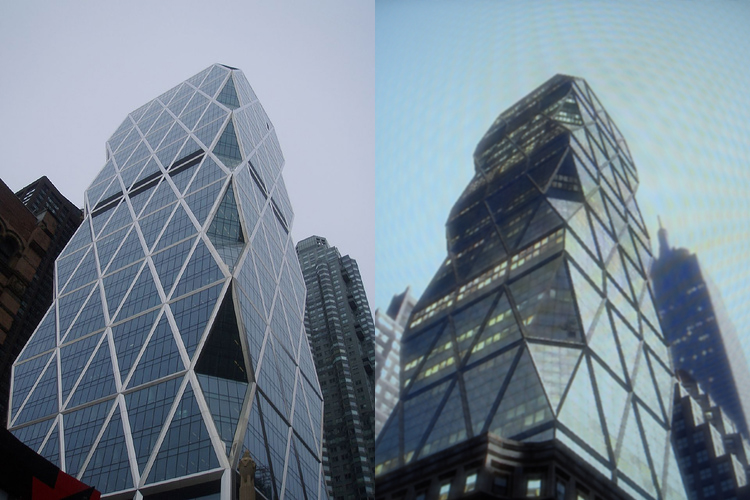
I can see Gayle King from here: New York’s Hearst Building (57th St. and 8th Ave.), home to O Magazine and others, and its GTA IV twin
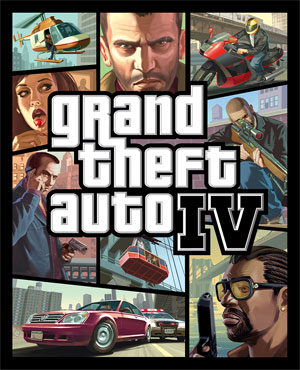 With the April 29 release of Rockstar Games’ (and, full disclosure, my former employer’s) Grand Theft Auto IV now nearly a month behind us, many are raving over the game’s raucus gameplay and sophisticated storyline. Still others are flabbergasted by the company’s reported game sales of over 6 million copies sold in the first week, including 3.6 million the first day, for a gross of half a billion dollars the first seven days of release, beating analyst projections widely. (These also beat Microsoft’s Halo 3 numbers, ’til now the biggest release. Little-known fact: In 2004, Grand Theft Auto: San Andreas also beat Halo 2‘s sales with, much the same, little fanfare.)
With the April 29 release of Rockstar Games’ (and, full disclosure, my former employer’s) Grand Theft Auto IV now nearly a month behind us, many are raving over the game’s raucus gameplay and sophisticated storyline. Still others are flabbergasted by the company’s reported game sales of over 6 million copies sold in the first week, including 3.6 million the first day, for a gross of half a billion dollars the first seven days of release, beating analyst projections widely. (These also beat Microsoft’s Halo 3 numbers, ’til now the biggest release. Little-known fact: In 2004, Grand Theft Auto: San Andreas also beat Halo 2‘s sales with, much the same, little fanfare.)
But whether you love video games, like I do, detest them, like my wife does, or are a voice actor for the GTA IV who doesn’t believe Take 2, Rockstar’s parent company, paid you enough, like Michael Hollick, if you’re New Yorkers playing GTA IV, there’s one thing you can all agree upon: The striking sense of verisimilitude with which the game overwhelms the player.
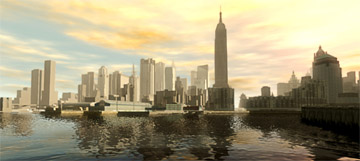 As notes Dave Itzkoff, in The New York Times (“A Strange City Called Home”), “The game makes no attempt to disguise the fact that it is designed to look, sound and feel like the city I have lived in for nearly all 32 years of my life.”
As notes Dave Itzkoff, in The New York Times (“A Strange City Called Home”), “The game makes no attempt to disguise the fact that it is designed to look, sound and feel like the city I have lived in for nearly all 32 years of my life.”
All the action in GTA IV takes place in a fictional locale called Liberty City, and
As many others have already noted, Liberty City is a dead ringer for New York: It’s divided into boroughs with distinct populations and architectural styles; it has most of the same suspension bridges and historic landmarks in the places you’d expect to find them; and its streets are always teeming with traffic and unruly pedestrians.
This game is hardly the first to try to replicate some portion of the New York experience — programmers have been trying to do this for decades. But Grand Theft Auto IV is the most contemporary attempt at this experiment, and may be the most realistic made available to a mass audience. …
For a native New Yorker, the game is both comfortingly routine and eerily disorienting; you find yourself playing because it is a limitless escape and a consequence-free confinement. Liberty City is like nowhere I’ve ever visited, even as it tries with all its heart and soul to remind me of a place with which I’m already intimately acquainted.
At one point, Itzkoff does what, perhaps, many New Yorkers will try to do when playing the game:
Having been lulled into believing that I really was in New York, I made the mistake of trying to find my own Alphabet City apartment within the game. I walked down to Chinatown — that took only a few seconds — found what I thought was Houston Street, and made my way to where Avenue A (and my apartment) should have been. But after traversing only a block or two of bodegas and backward-hatted hipsters bobbing their heads to the beats of miniature iPods, I somehow found myself at the southern entrance to Grand Central Terminal.
It was as if some unknown natural disaster had recently touched down and attacked only the portions of New York that I cared for most deeply. My city — at least, the parts of it that I thought of as my city — no longer existed.
So I regrouped and tried to find the high-rise apartment building on East 40th Street where I grew up in the ’70s and ’80s. I started at the United Nations, made my way west through a perfect simulacrum of Tudor City (with another saxophone player performing in the park) and within a few short steps had gone all the way to St. Patrick’s Cathedral. Foiled again!
It seemed a perfectly logical and human impulse, to prove to myself that I was somewhere recognizable by finding the one place in it that was most recognizable to me. Yet there was no way that the game could satisfy this impulse: like a comic-book superhero drawn by the legendary artist Jack Kirby, whose characters’ fists grew larger and feet grew smaller as they flew up out of their panels, the proportions of this version of Manhattan were an optical illusion. The parts that everybody would notice were blown up larger than life; the parts that virtually no one would care about were shrunk to nothingness.
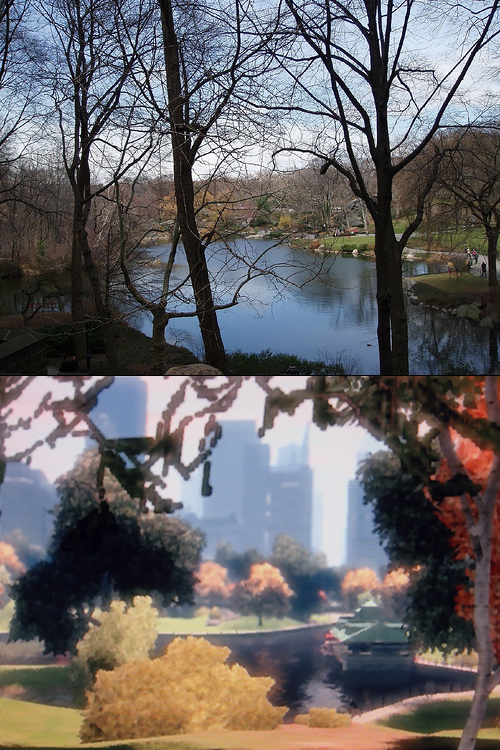 Itzkoff’s tenacity is remarkable, but nowhere near the dedication of non-New Yorker Matthew Johnston. His “Sightseeing in Liberty City” Flickr photoset turns a tourist’s upward gaze not only on New York, but on GTA IV‘s simulacrum, matching shots of real-life architecture in NYC with buildings in the game. (Thanks, Kotaku, for the tip.)
Itzkoff’s tenacity is remarkable, but nowhere near the dedication of non-New Yorker Matthew Johnston. His “Sightseeing in Liberty City” Flickr photoset turns a tourist’s upward gaze not only on New York, but on GTA IV‘s simulacrum, matching shots of real-life architecture in NYC with buildings in the game. (Thanks, Kotaku, for the tip.)
That’s Johnston’s twinned image, right, of the rocky outcropping overlooking the lake in Central Park, near W. 75th St. On top is the photo, at bottom, the game.
At the top of this post, above left, you can see the Hearst Building, home of the famed publisher, with its dopplegänger at right. As well, in the GTA Hearst shot, one recognizes the geographic compression Itzkoff describes: Can a person really view the Empire State Building, as it is shown on the shot’s right edge, from 57th & 8th? It’s somewhat akin to Saul Steinberg’s oft-reproduced 1976 New Yorker magazine cover, View of the World from 9th Avenue, below. (Like GTA IV, Steinberg’s artwork doesn’t have a Staten Island either.)
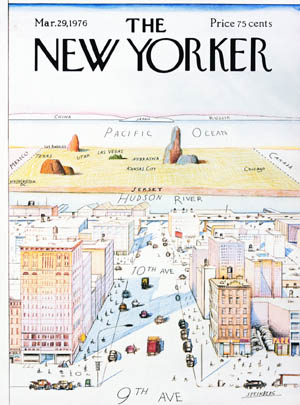 Just like a tourist, Johnston sometimes doesn’t know where he is, either: His attempt to match GTA IV‘s version of St. Patrick’s Cathedral in Midtown sent him sixty blocks north to Harlem, from which he brought back a picture of the Cathedral of Saint John the Divine.
Just like a tourist, Johnston sometimes doesn’t know where he is, either: His attempt to match GTA IV‘s version of St. Patrick’s Cathedral in Midtown sent him sixty blocks north to Harlem, from which he brought back a picture of the Cathedral of Saint John the Divine.
Yet these are quibbles over what is, really, a rather ardent expression of both physical and digital reconnaissance. What’s amazing about this is not just the increasing realism in games, but the way that architecture, in games, is increasingly, not only part of the way the game is played, but part of the meaning and understanding people receive from the experience.
This is an area in which I have an acute interest, I should add. I think that not only are we entering a fascinating new period in this area, but I also believe that we’re going to see many diverse approaches to this aspect of gaming as we go forward. We’ve only begun to build.

0 comments ↓
There are no comments yet...Kick things off by filling out the form below.
Leave a Comment